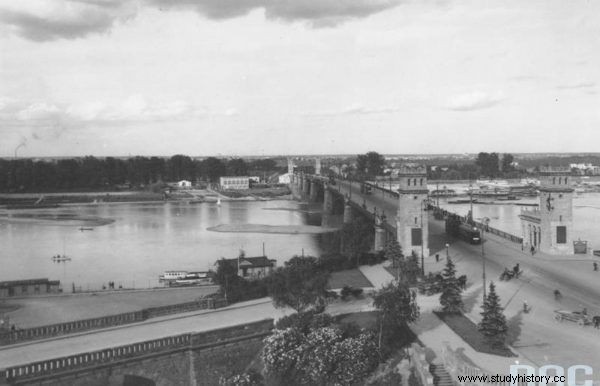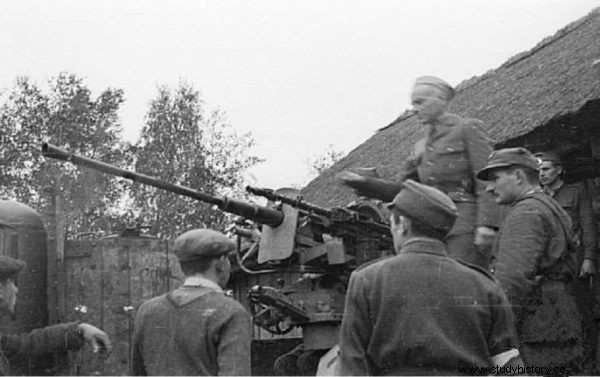On October 2, 1944, the Warsaw Uprising ended, the greatest uprising and, at the same time, the greatest defeat in our modern history. The uprising crushed into the political and military situation of the summer of 1944 had no chance of success. If we add to this the lack of armament and the imbalance of forces on both sides, issuing the order to fight in the city seems to be a crime. The balance was tragic:it is assumed that the losses of the civilian population amounted to approximately 150,000–180,000, and among the insurgents to approximately 18,000. The left-bank part of the city was destroyed in 85%. The rest of the population was driven out of the capital. The city was about to cease to exist.
The Command of the Home Army, during the fights, set many tasks for the insurgents which, due to the lack of weapons, communication, reconnaissance, coordination of activities, or the incompetence of the commanders, had no chance of success.
On August 1, attempts to capture the bridges over the Vistula River, especially the Poniatowski Bridge, ended in failure. This facility was to be of key importance for the possible arrival of aid from the other side of the Vistula. The Germans understood this perfectly well, so earlier, just in case, they mined the bridge.
The task of capturing Poniatoszczak fell to the insurgents from the "Konrad" group. In the three platoons designated for the attack, the insurgents had pistols, one Schmeiser and the Bren machine gun, which, in addition, they could not handle too much. Their attack naturally collapsed after the fire directed by the Germans. The attack from Prague also failed. There the insurgents were detained by paratroopers from the Herman Goering division. The case was similar with the Kierbedź Bridge.

Poniatowski Bridge
Another unsuccessful action was an attempt to break through from the Old Town to Śródmieście on the night of August 30-31, 1944. This time, the reason for the defeat was not the shortage of weapons, as on August 1, but the inability to coordinate the actions taken. The plan was to break a corridor about 800 meters long and 400 meters wide, which would allow the defenders of the Old Town to be evacuated to Śródmieście. In spite of potentially optimistic plans, almost everything failed just before the attack . The basic mistake was the lack of recognition of the German side. The insurgents did not know what forces the Germans had and where their main points of resistance were located from the side of the Old Town.
The second reason for the failure was the lack of communication between the Old Town and Śródmieście. Additionally, the failure of the action was influenced by the chaos caused by the leakage order. Civilians took to the streets fearing that the insurgents would leave them to the enemy. The streets of the Old Town were blocked. Stanisław Podlewski recalled:
When it was dark from all the shelters, basements and burrows almost covered with heaps of rubble, hordes of people with bundles and bundles began to emerge. (...) On this macabre night, no one is able to hold in his hands a disgusted and shaky swarm of people, absorbed only in the thought:whether it will be possible to get out of this oppression.
Insurgent units could not get to their starting positions. The noise and confusion aroused the vigilance of the Germans. Colonel "Wachnowski", commander of the Old Town, moved the action to 1.00. However, no one informed the Old Town about it. Lack of connectivity resulted in a lack of coordination in hitting simultaneously . The attack began in Śródmieście, but it did not receive support from the Old Town. Additionally, the command of the Home Army planned a landing through the sewers to Plac Bankowy. According to intelligence, the square was to be poorly defended, and after opening the hatch, it turned out that a powerful German detachment was stationed there. The landing operation ended when it began, although a dozen or so Home Army soldiers undertook an unequal fight with the Germans. The only group that managed to break through from the Old Town was the unit of "Andrzej Morro" from the "Rudy" company. The insurgents, pretending to be Germans, passed through the Saxon Garden unstoppable and reached the stock exchange buildings occupied by Poles.
Meanwhile, about 1,500 partisans, decently armed, were stationed in the Kampinos Forest in the first weeks of the uprising. On August 14, General "Bór" gave an order that all Home Army units operating in the area should start helping Warsaw. It was another tragic order . Commanders of units from the forest:captain Józef Krzyczkowski "Szymon" and lieutenant Adolf Pilch "Dolina" reacted immediately. A training camp from Kampinos has moved to Warsaw. In the first wave, about 500 partisans managed to get to Żoliborz, in the second one another half a thousand made their way.

Major Alfons Kotowski ps. "Okoń" among the soldiers of the "Kampinos" Group
Major Alfons Kotowski "Okoń" was delegated from Warsaw to Kampinos to take command of the entire grouping. It was also there that the idea of an attack on the Gdańsk Railway Station was born in order to break through from Żoliborz to the Old Town. The "Foresters" did not really trust "Okon". The creator of the attack plan was Lt. Niedzielski.
The forces that got to Żoliborz were to help the insurgents and break through to the Old Town. The only place (apart from the idea of passing through the sewers, which was rejected by the command) was Dworzec Gdański - a strongly manned bastion supported by the armored train PP 75. The action was scheduled for August 20. The insurgents had about 1,300 well-armed soldiers. Then reconnaissance, errors in command, tragic communication and planning of the attack together with its coordination failed again .
Initially, it was believed that the Gdański Railway Station was occupied by a few German resistance points. In fact, it was a strong grouping of bunkers. The beginning of the attack was going according to plan. Later, the insurgents were flooded by the fire of German artillery and heavy machine guns. Few have reached the tracks. The signal to attack the second throw was supposed to be the green racket, but it got lost somewhere ... The support that the attackers from Starowka were to receive was also insufficient. The Poles withdrew to their starting positions with losses. Despite the failure, the command resumed action the next day. This time, the Germans 'dealt' with an armored train blocking the track line. This is how Andrzej Paszkowski "Dzik" recalled the attack:
We are in the middle of Hell, being fired on from three sides. They hit us with heavy infantry and artillery weapons. The whole area is constantly covered with thousands of missiles. (...) And at the same time an armored train arrives, firing guns and machine guns
At 4:15 the commander-in-chief of the action ordered a retreat. When the partisans withdrew, the Old Town had not yet moved from its starting positions ...
The attack on the Gdańsk Railway Station was one of the bloodiest combat actions of the uprising . Polish losses amounted to about 600 killed and wounded.
Let us consider what could happen if the actions carried out by the insurgents were successful? Would anything change? It is possible that the city's agony would lengthen for more weeks. Maybe the Poniatowski Bridge could be used to evacuate civilians? Or maybe the Soviet relief would start and there would not be another "insurgent defeat", i.e. the landing of the Berlingers? We never know that…
